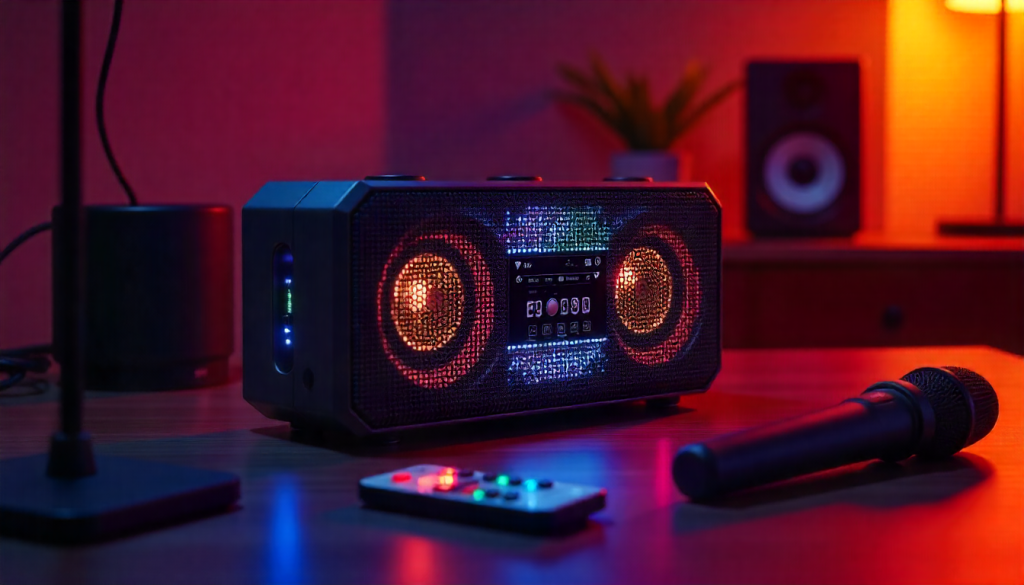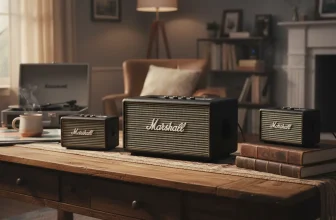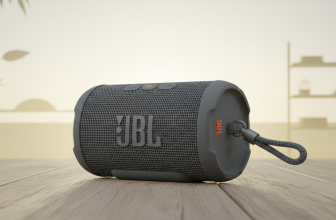
Have you ever been at a party and, as somebody takes the microphone to sing, all that comes out is static and feedback? So that was my first time pairing a Bluetooth mic to a Bluetooth speaker. I had really thought it would be a two-minute setup of flicking both on, pressing the pair, and the magic would kick in. Instead, it became a mini tech horror show in which I could hear my own voice echoing back at me, and my friends only laughed instead of clapping.
I’ve learned over the years how to connect a Bluetooth mic to Bluetooth speaker setups properly–believe me, once you know how it’s done, you’ll never want to go back to again tangle of wires again. Whether it’s a karaoke night, an important work presentation, or a gym fitness class, with this simple wireless combo, you’re set to avoid some serious embarrassment and awardness.
Check Latest Price
This long-form guide will take you through:
- Why this setup matters.
- Step-by-step connection methods.
- Common problems (with full solutions).
- Apply them in more practical and daily uses.
- FAQs that answer real-world concerns.
Why use a Bluetooth Mic to Bluetooth Speaker?
The fundamental logic is freedom and convenience. No more does one have to lug those bulky wire systems, fear falling over wire, or confine their movements to standing in one place. In combination with a Bluetooth speaker, this smooth mic offers an innovative all-in-one sound system.
Everyday Benefits
Work Presentations
Picture yourself strolling a conference room floor with a hand-held mic, and your voice is booming out of an easily portable speaker. No wires, no awkward pauses — it’s something that makes you look nice and confident.
Karaoke Nights
Friends and family are obsessed with karaoke, but your cell service is not the best thing for them. If you have a good setup, your voice will come through clean and clear, which makes for a more enjoyable night, even if your singing isn’t award-winning.
Fitness & Classes
As teachers, you have to move, present, and talk all at the same time. Whether it’s a Bluetooth mic to a Bluetooth speaker so they can keep moving, or just not hearing music that sounds like it was recorded with the band inside of a tin can, you want them to be able to hear what you’re hearing.
Home Entertainment
Hosting a party? Streaming a live event? A person with a wireless mic and Bluetooth speaker can make his/her living room into a stage.
The Bigger Picture
There are more than 1 billion Bluetooth devices that ship globally per year, according to Statista. Wireless audio is just the way things are now, not an exception. People want cable-free, portable solutions — and from what I can tell, this set-up is not going to let them down.
How to Connect a Bluetooth Mic to a Bluetooth Speaker
Here is the simple but essential step-by-step process:
Step 1: Check Device Compatibility
Some microphones do not connect directly to speakers. Some are plug-and-play ready, while others (especially professional-grade mics) may need adapters or mixers.
Tip: Be sure to read product details. Search for phrases such as “direct Bluetooth speaker pairing.
Step 2: Enable Pairing Mode
- On the mic: Press and hold the Bluetooth/power button until the LED flashes.
- On the speaker: Do the same. In the case of many other devices, there’s a spoken “Ready to Pair.”
Step 3: Pair the Devices
When you hear the mic is ready for use, it’s discoverable to your speaker. If your mic does not pick up the speaker, in all likelihood, it is not end-unit pairable — that means you will need to use an additional transmitter (or small mixer).
Step 4: Test the Connection
Try speaking through the mic: “Testing, one, two.” You ought to be able to hear yourself over the speaker. Adjust the volume of two devices to make the sound balanced.
Step 5: Take care of latency and echo.
Bluetooth can cause a little delay in the audio (latency). Just makes you sound like Elvis at karaoke or live speaking, tho.
Reduce it by:
- Keeping devices close together.
- Using higher-quality, low-latency equipment.
- Reducing mic gain to avoid echo.
Extra Use Cases for Bluetooth Mic to Bluetooth Speaker
Podcasting or Live Streams
For simple setups, small creators can get started with only a wireless mic and Bluetooth speaker.
School & Education
Teachers can use the system in a classroom to ensure that every student hears them.
Events & Gatherings
It’s easily set up, then taken down in mere minutes, and stored away in no time. Great for family gatherings, church events, and community get-togethers.
Travel & Camping
Carry a portable outdoor Bluetooth speaker and mic to keep the good times going outdoors.
View Details On Amazon
Sync Two Alexa Speakers
This ability to pair Alexa devices together is a game-changer for anyone who wants richer, fuller sound. When you sync two Alexa speakers, the sound separates left and right by default, for a stereo experience. This gives music more life and adds depth to podcasts, audiobooks, or even daily news briefings.
The process is easy as pie: Open the Alexa app, tap “Combine Speakers” and the stereo pair. You can also sync speakers for multi-room audio, in addition to stereo. So picture this: You’re walking from your kitchen to your living room and the same playlist is following you there seamlessly, working seamlessly — no drop-offs, nothing cut off. If you’re a professional, this is useful in a meeting or small event where one Alexa isn’t loud enough to carry through the room.
Can I pair additional Bluetooth speaker to Alexa
Yes, you can make Alexa’s sound stretch farther than her built-in hardware with extra speakers. Can I pair an additional Bluetooth speaker to Alexa to extend the reach of your audio? For example, you can leave Alexa on your desk while the sound fills up your whole living room through a large Bluetooth speaker.
That can be really handy when you want to host a group event, present something to others, or you just need improved audio clarity than what Alexa’s internal speaker offers. The connection is made in the Alexa app — it will ask you to select your device and then have you navigate to Bluetooth settings and choose “Pair a New Device.” In seconds, you have cleaner, more powerful-sounding music all around the room.
Bluetooth Speaker Television & Wireless Bluetooth Speakers for TV
Let’s face it: TV speakers suck, and that’s why so many people turn to Bluetooth speaker television or go as far as to buy the best soundbars for TV. These speakers improve the clarity, volume, and fullness of sound.
The most important thing to check is latency. Low-budget Bluetooth speakers can cause lip-sync issues, where the mouth movements of the actor don’t match up with the dialogue. This is where some good wireless speakers, preferably the ones with aptX Low Latency that we mentioned earlier, come in handy. Wireless Bluetooth Speakers For TV are great for:
- Movie nights with friends.
- Gaming matches when speed is critical.
- Live sports, when audio lag means you’re missing the moment.
They also help streamline your setup by eliminating tangled cords.
Microphone Through Bluetooth Speaker
Some people also wish to connect a microphone through Bluetooth speaker for karaoke, as well as live speaking or fitness classes. Certain Bluetooth microphones connect directly; others connect with a wireless transmitter or mixer.
When it comes to karaoke, these are a great idea as they come with built-in echo control and vocal effects, making the experience even more enjoyable. For business use, an instant plug &play design–no driver required pairs with a mixer for stable connections and good sound quality. The advantage is in the name: mobility — you can move around while speaking or singing, without being limited by wires.
Roku Bluetooth Speaker
The Roku Bluetooth speaker is solely designed for Roku TVs and gadgets. It’s also easy to install and offers improved audio for films, TV shows, and streamed content.
The key advantage is that it’s plug-and-play — you don’t have to do anything too complicated to set it up. It plugs directly into your Roku system, so the sound syncs up with the picture. It’s fantastic for entertainment but not so great for live mic use since Bluetooth mic pairing can introduce lag. Still, for TV-centric households, this is a relatively inexpensive and effective upgrade.
Milwaukee Bluetooth Speaker and Milwaukee M18 Bluetooth Speaker
The Milwaukee Bluetooth speaker system is designed to withstand rough job site conditions such as extreme cold and heat, rain or shine. They are famous for their durability, being dustproof, drop-resistant, and tough-weather friendly.
The Milwaukee M18 Bluetooth speaker is the premier model. It’s powered by Milwaukee’s M18 Battery System, which provides great portability and all-day runtime — things that are critical on the jobsite. (“Armor” is short for “Armored Fighting Vehicles.”) It’s perfect for professionals who require high-decibel, clear sound in harsh environments. You can throw it in your work truck, and I mean that literally, and it also performs again and again.
Turtlebox Ranger Bluetooth Speaker
For wild outdoor adventures, the Turtlebox Ranger Bluetooth speaker is a monster. It’s waterproof, weatherproof, and impact-resistant. A camping, boating, beach, or hunting trip, the BravaWhale Portable Speaker gives off big sound even in wide-open, noisy spaces.
While many portable speakers are no match for open spaces, the Turtlebox is designed to cut through wind, distance, and background noise. If you’re searching for a speaker that can survive rain, dust, and being flung around while providing powerful bass and clear vocals, look no further.
Walla Sound Bluetooth Speaker & Sylvania Bluetooth Speaker
Walla Sound Bluetooth speaker: Small size, portable carry convenient to carry, suitable for small spaces and private use.
Sylvania Bluetooth Speaker: Cheap, functional, and adequate for background music at home or the office.
These models are not premium performers, but for the price, they’re a good fit for people who just want a plain-jane speaker that does its job without complications.
JBL 615 Speakers
The JBL 615 speakers are designed for a big room, a party, or a gathering. They deliver loud, clear audio and are great for karaoke nights or to use in a conference room or fitness studio.
JBL has a reputation for reliability, and there we’d feel the 615 is no different—coping with loud music with ease. If you take your sound seriously, this speaker can provide the clarity, power, and finesse required for professional use, or even to add basis to your high-end home theater system.
Marshall Speakers
Marshall speakers are distinctive thanks to their nostalgic design and modern features. They’re pretty enough to pull double duty as decor, but loud enough to fill a room with sound.
If you’re hosting smaller dinner parties or using it for personal use, like a professional at the office, Marshall speakers are the best choice. They combine good looks with the ability to deliver high-quality audio—appealing to anyone who appreciates good aesthetics and sound.
Common Problems with Bluetooth Mic to Bluetooth Speaker and Solutions
Even when you have the best gear, the Bluetooth mic-to-Bluetooth speaker connection isn’t ever perfect. Here are the most common problems people encounter, along with easy solutions:
Echo or Feedback
The Problem:
You talk into the microphone, and instead of your voice emanating out clean, it squeals sharply or repeats back on itself.
Solutions:
- Ensure that the microphone is placed at a minimum 6–10 feet from the speaker.
- Don’t point the mic right at the speaker.
- Decrease the gain or sensitivity setting on your mic.
- Use echo suppression or noise cancellation if your mic has it.
- Put some curtains/carpets in rooms with hard stuff so reflections are not as strong.
Lag or Delay (Latency)
The Problem:
Your voice sounds through the speaker a fraction of a second after you speak.
Solutions:
- Pair devices with the aptX Low Latency codec.
- (Microphone and speaker should be close (10-15 feet).
- Make sure you have turned off other Bluetooth devices to minimize interference.
- For critical events, maintain a wired option as a backup.
Pairing Failures
The Problem:
Your mic doesn’t properly connect to your speaker.
Solutions:
- Reset both devices.
- Clear old connections.
- Make sure they are not already paired with something else.
- Try to match at close range again.
- If everything else fails, your mic may require a transmitter/mixer.
Volume Imbalance
The Problem:
Either your voice is too low or too high compared to other sounds.
Solutions:
- Adjust the microphone gain gradually.
- And finally, balance out the relative speaker volume.
- Or use a “vocal priority” mode if it’s an available feature.
- :> Always test before events “testing, one two”
Battery Drain
The Problem:
The mic or speaker goes dark in the middle of a meeting.
Solutions:
- Fully charge before use.
- Keep a power bank handy.
- Opt for long battery life speakers (8–12 hours).
- For pro use, buy tools with removable batteries.
Interference or Signal Dropouts
The Problem:
The sound drops or pops.
Solutions:
- Stay within 30 30-foot range.
- Stay away from the walls, metal materials covering the phone blocker.
- Avoid Wi-Fi routers and microwaves.
- Use hardware with at least Bluetooth 5.0.
Distorted or Poor Audio Quality
The Problem:
Sound is dulled or distorted, or noisy.
Solutions:
- Use a higher-quality mic and speaker.
- Check for a low battery.
- Wipe the mic grill and speaker face down.
- Update firmware if available.
Pro Tips for the Best Bluetooth Mic to Bluetooth Speaker Connection
- Consider Range: Stay under 30 feet.
- Pre-charge Devices Before Use: Never cut off unexpectedly.
- Test Before Events: Small sound checks can help avoid embarrassment.
- Avoid barriers: Devices do best when there’s a clear line of sight between them.
- Quality Matters: Better devices mean less drama.
FAQs
1. How can I link a Bluetooth speaker with a Bluetooth mic?
Put both devices into pairing mode, go to Bluetooth settings, and connect to the speaker.
2. Why does my Bluetooth mic-to-Bluetooth speaker setup have latency?
Bluetooth adds latency. When you can, use low-latency models and go the shortest distance.
3. Can you use a Bluetooth mic and a Bluetooth speaker for karaoke?
Yes. It’s a common thing to do — just pick one known for good volume and clarity.
4. Is a Bluetooth mic to Bluetooth speaker good for office presentations?
Definitely. It enables move freely, yet you can still hear each other clearly.
5. My Bluetooth mic – Bluetooth speaker set up is feeding back. How can I fix this?
Gainstrip and face away from the speaker.
6. Does this setup work for outdoor use?
Yes, just make sure your speaker is loud and has good battery life.
7. What is the easiest way to test a Bluetooth mic to speaker connection?
Say “testing, one, two.” If the echo or lag never comes, then you’re in business.
Conclusion
At the end of the day, a Bluetooth mic to Bluetooth speaker arrangement is about freedom: freedom of movement and ease of use. You don’t need to be a sound engineer to make it work — you just need the right microphone, the right speaker, and some practice.
Whether you’re talking at the office, singing a tune at that party, or teaching your class (from a safe distance) on the playground, even outside in your backyard, this easy-quirky trick offers you clear sound so everyone can hear what you have to say.
And the best part? You’ll never struggle with tangled cords again after you learn it, by the way.










